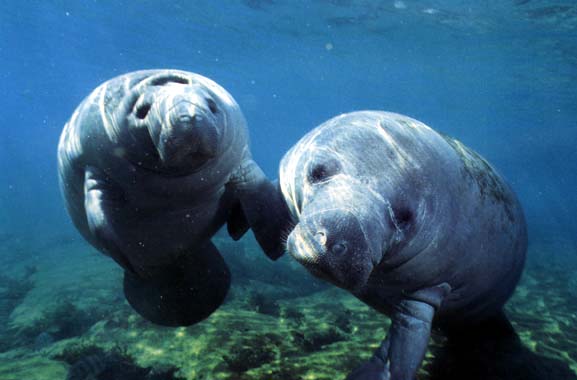
Monday,
Things are looking up for the manatee, state scientists say. Its population is growing, enough that the state will consider this year whether to lift the animal's endangered status, moving the manatee to the threatened category.
But activists for the portly, wrinkly-skinned sea cow are skeptical, especially in light of last year's mortality figures. In 2005, 396 manatees died statewide, the second highest count since the state started tracking the data in the mid-1970s.
The preliminary figures, which scientists will review for many more months, have only fueled the heated debate about manatees' health.
"To me it's astounding that we could tolerate a mortality rate like this in an endangered species," said Greg Bossart, a veterinarian and pathologist with Harbor Branch Oceanographic Institution north of
Last year there were 25 manatee deaths in St. Lucie, Martin and
In St. Lucie County, manatee deaths jumped from one in 2004 to eight in 2005. Scientists couldn't determine a cause in five of those deaths.
Eight manatees died in
In
Statewide, scientists couldn't determine a cause in more than 100 of the deaths in 2005. Eighty manatees were killed by watercraft, and another 81 died because of red tide, the toxic algae bloom that plagued the southwest coast for most of last year.
The only other year with a higher death count was 1996, when the state reported 415 manatee mortalities. Red tide was in bloom that year, too.
Scientists caution against an alarmist reaction to the latest death figures. Just because the numbers spiked in 2005, it doesn't mean it's the start of a long-term increase. "You can't pull a trend out of one year," said Ken Arrison, a biologist with the Florida Fish and Wildlife Research Institute.
In 2004, for instance, the commission reported a significant drop in the number of manatee deaths: 276, down from 370 the year before. But 2004 was also the year four hurricanes crossed the state. Though scientists have yet to pinpoint a single reason for the decline, it might be that fewer people were boating, Arrison said.
A look at that year's number of deaths caused by watercraft, however, shows only a slight dip, from 73 in 2003 to 69 the next year. The biggest drop was in natural deaths: in 2003, the number was 102; in 2004, the commission reported 24 natural deaths.
State scientists say population estimates, coupled with survival and birth rates, are more significant than the number of manatees that died in a single year.
"I think the population is doing much better than it did 20 years ago," said Elsa Haubold, program administrator for marine mammal research at the Florida Fish and Wildlife Research Institute.
In 1992, for instance, an aerial survey counted 1,844 manatees in the state. Last year, an aerial survey counted 3,143. In the years between, aerial survey counts varied by as much as 1,000 from one year to the next.
State scientists are the first to admit the aerial surveys are flawed: Observers might miss a manatee, or count one more than once.
"If it's windy, if there's a big glare, if it's really cold — different things can affect these counts," Haubold said.
Even so, state scientists say two of the four
But those account for only about 16 percent of the state's total sea cow population, said Patti Thompson, director of science and conservation for the Save the Manatee Club.
Scientists agree that the remaining two sub-populations aren't doing so well: The Atlantic group is stable, though possibly increasing or decreasing slightly; the southwest group probably is declining.
Thompson said those factors alone should dissuade the state from stripping the manatee of its endangered status, a move petitioned by the saltwater anglers' group, the Coastal Conservation Association.
"You had all these groups alleging that the manatee populations were declining and were on the brink of extinction, and that simply wasn't true," Ted Forsgren, executive director of the group's
"We knew, because we have guides as members, people who are out on the water every day, and they can tell you that 25 years ago, there were not nearly as many manatees as there are today."
A panel of five state-appointed scientists seemed to agree. This month, the scientists recommended the manatee be reclassified as threatened, which means the chance is greater than 50 percent that the species will be extinct in three generations, said Haubold, who chaired the panel. By contrast, an endangered species has a chance greater than 80 percent of becoming extinct in that time period.
The Florida Fish and Wildlife Conservation Commission will consider the change this summer.
A reclassification wouldn't immediately remove any protections, Haubold said. But some activists fear it could make it harder to put additional protections in place.
"There's really nothing we can do about red tide except learn more," Thompson said. "But we're not doing enough to address those things that we can control. We can minimize human-related deaths, especially those related to watercraft."
Last year's was the fourth highest number of watercraft-related manatee deaths on record. The state needs to expand low-speed boating zones and better enforce the ones that exist, Thompson said.
Forsgren said he doesn't oppose speed zones; the state just needs to do a better job of deciding where to put them. In some cases, the zones have forced boaters into deeper waters, where it's harder to spot manatees and avoid hitting them, he said.
prefer to rent?: selected lease properties
sample our portfolio: properties for purchase
condominium happenings: local condo scene
south florida communities: lifestyles
our daily updates: waterfrontlife blog page
contact information: waterfront life representative


